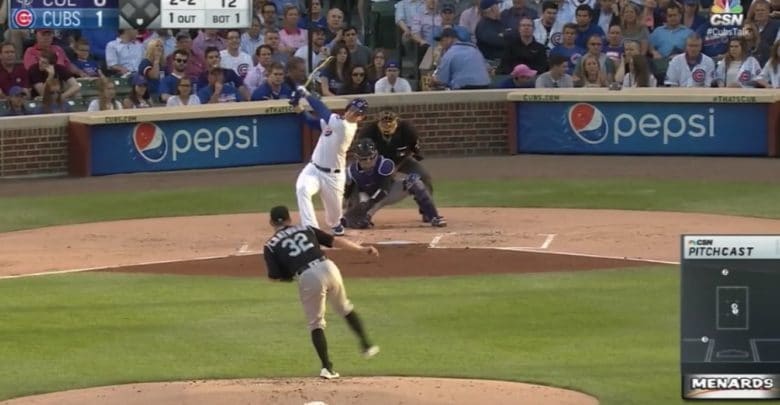
Meet Tyler Chatwood, Peripheral-Stats Dream with High Ceiling
“That’s Cub” can have several meanings. Some use it when describing the selfless culture that has been curated on the North Side. Others use it as an expression of the Cubs’ consistent success over the last several years. And then you’ve got the team’s most recent transaction.
Signing Tyler Chatwood, that’s Cub.
When I took my phone out of my pocket after it buzzed for 15 seconds straight, I figured it was a weather alert for the Los Angeles fires. To my surprise, it was messages and notification to the effect of “Cubs got Chatwood.” An excessive number of joyous expletives left my lips, startling the many people around me, but for good reason.
Chatwood put ink to paper on the Thursday before the annual Winter Meetings, guaranteeing himself $38 million over three years ($12.5M in ‘18 and ‘19, $13M in ‘20) with a basket of incentive goodies. Youth, a diverse pitch repertoire, appealing movement peripherals, impressive pitch-type statistics, and money are all prime reasons Theo Epstein signed Chatwood. And, of course, the Cubs would target a pitcher with a high ceiling.
In this post, I’ll describe why I am so excited about the Cubs signing of Chatwood.
Pitch usage
Chatwood has five pitches in his arsenal. The former Rockies starter typically utilizes fastballs, sinkers, and sliders, then he’ll spin a curveball once every 10 pitches and a changeup four times per 100 pitches.
The velocity separation between his pitches is notable. In particular, Chatwood will show a 95 mph four-seam and sinker, then keep batters on their toes with an 80 mph curve. But his most-employed secondary pitch, the slider, is thrown 90 mph, faster than 98.8 percent of all such pitches since 2007. For the sake of reference, that’s like a slightly faster version of Jake Arrieta’s slutter.
Pitch movement
FanGraphs’ Eno Sarris beat me to the punch and examined how Chatwood’s pitch movement compares to the rest of MLB. Using the most recent data, Sarris shows that Chatwood’s four-seam and curve spin rate are among the highest in baseball. Only seven and four percent of pitchers throw four-seams and curves with more spin, respectively. Now all the buzz in the baseball analysis world, spin rate was made famous by the Astros’ identification of the RPMs of Charlie Morton’s pitches. We know how that story ended.
Sarris’s most interesting finding is that Chatwood’s pitch movement is predictably better away from the abnormal environment of Coors Field. When pitching closer to sea level, the 28-year-old gains about half an inch of movement — especially vertical drop — on most pitches. His curveball drop, for example, is in the 94th percentile compared to the 83rd percentile when toiling in his old home park.
Chatwood’s spin rate suggests his pitches are top-tier, and, even more important to the Cubs, it suggests he could be better when pitching in a home park that’s not akin to an ICBM test site.
Impressive pitch-type whiff rates
Looking at Chatwood’s individual pitch whiff rates is where this gets extremely fun. Every one of the righty’s pitches garners above-average whiffs, especially his fastballs. Both his four-seam and sinker generated at least 75 percent more whiffs than other starters. And when he does throw changes (again, only 4 percent of the time), he’ll induce 84 percent more whiffs than other starters.
Consider how Chatwood’s 23 percent overall whiff rate was roughly two percent better than average. But, as Sarris mentioned above, Chatwood’s improved vertical drop away from Coors Field could lead to even more whiffs when curves are thrown. That, my friends, is precisely why I’m in love with this move.
| Pitch | Whiff Percentile |
| Four-Seam | 75 |
| Sinker | 82 |
| Slider | 58 |
| Curve | 63 |
| Change | 84 |
Grounders
Chatwood’s 58 percent ground-ball rate in 2017 speaks volumes. Only four other pitchers who accumulated at least 140 innings generated a higher percentage So let me paint you a picture.
Imagine a beautiful summer afternoon at Wrigley. Chatwood is on the mound. He just struck out 7 batters in the first 5 innings with a devastating curve/sinker/slider combination, though opponents are finally beginning to make contact.
Ah, but now Addison Russell and Javy Baez are teaming up to perform superhuman double plays and diving stops. An extreme ground-ball pitcher in front of one of the best defensive middle infield duos in MLB? Oh, the base hits that will be eliminated.
What to expect
The Cubs signed a pitcher with a ceiling as high as a the W flag atop the Wrigley scoreboard, but Chatwood does have his drawbacks. Big ones.
First and most obvious are the Tommy John surgeries. Yes, plural. He’s been under the knife twice to have his pitching elbow reconstructed, once as a teenager and again in 2014. Then you see that he has never thrown more than 160 innings in his career. Further, the flamethrower has a career BB/9 of 4.12.
All this means the Cubs probably won’t be relying on Chatwood to lock in 30-33 starts like Jon Lester does each year. Acquiring more pitchers is still a necessitity given the uncertainty.
Which is why the 2016 World Series champs only had to dish out $38 million. All Chatwood has to do to live up to that contract value is produce roughly 1.7 fWAR per year, depending on which $/WAR model you like. I’ll take that bet and double down.
Finally away from Denver and now with a team that just acquired one of the most esteemed pitching coaches in baseball in Jim Hickey, Chatwood could flourish in blue pinstripes. This is a pitcher who throws over 95, possesses a diverse repertoire with impressive whiff rates, induces tons of grounders, and whose stuff has played better on the road in the past. It’s not hard to see why the Cubs executives made the deal.




